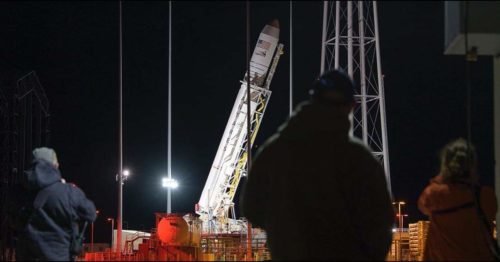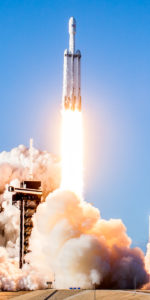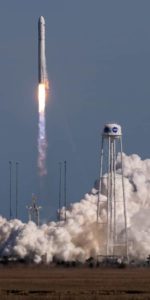Roger Chaffee never got to fly in space. Selected by NASA as a member of the space agency’s third group of astronauts—alongside future Moonwalkers Al Bean, Buzz Aldrin, Dave Scott and Gene Cernan—he was the youngest of his class and in March 1966 drew his first plum flight assignment as pilot of the first manned Apollo mission. Sadly, ten months later, on the evening of 27 January 1967, he and crewmates Virgil “Gus” Grissom and America’s first spacewalker, Ed White, were killed in a flash fire aboard their Apollo 1 command module. Chaffee was three weeks shy of his 32nd birthday.
More than a half-century later, on Wednesday, 17 April, the Navy lieutenant-commander will fly in name at least to the International Space Station (ISS), when Northrop Grumman Innovation Systems—formerly Orbital ATK and, before that, Orbital Sciences Corp.—launches the NG-11 Cygnus cargo ship atop an Antares 230 booster from Pad 0A at the Mid-Atlantic Regional Spaceport (MARS) on Wallops Island, Va. Laden with 7,500 pounds (3,400 kg) of experiments, equipment and supplies for the incumbent Expedition 59 crew, the “Spaceship (SS) Roger Chaffee” will approach and berth at the space station early Friday, 19 April, with astronauts Anne McClain of NASA and David Saint-Jacques of the Canadian Space Agency (CSA) at the controls of the 57.7-foot-long (17.6-meter) Canadarm2. Monitoring Cygnus’ systems during the approach will be fellow Expedition 59 crewman Nick Hague. According to the schedule, McClain will grapple the cargo ship at 5:30 a.m. EDT, whereupon ground controllers will command Canadarm2 to rotate and install Cygnus onto the Earth-facing (or “nadir”) port of the station’s Unity node.
Follow our LAUNCH TRACKER for regular updates and LIVE COVERAGE on launch day!
.
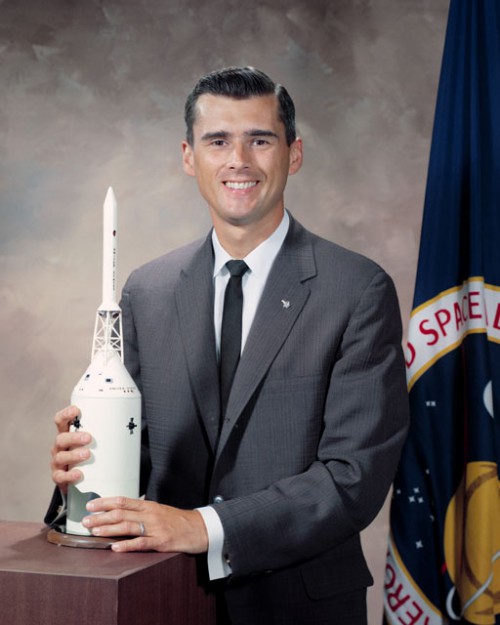
Roger Chaffee became the youngest person ever selected by NASA for astronaut training in October 1963. Photo Credit: NASA
NG-11 will demonstrate, for the first time, the ability to “late-load” cargo aboard the spacecraft, just 24 hours prior to launch. This will allow for time-sensitive payloads, including the live rodents aboard NG-11, to be safely transported to the ISS. Under the processing regime for previous Cygnus missions, the last cargo was loaded about four days before launch, with the vehicle rolled out to the pad at L-2. On 11 April, Northrop Grumman announced that Cygnus was fueled and its initial cargo load had been completed, ahead of encapsulation in the Antares payload fairing and rollout to Pad 0A at MARS.
“An area of high pressure will press down from the Northeast states Wednesday morning, forcing a backdoor cold front through the Wallops Region to shift surface winds out to a northeasterly component for the launch window,” noted Wallops’ L-2 weather briefing on Monday. “A weak upper-level disturbance within the northwesterly upper-level flow will track towards the Mid-Atlantic Wednesday to increase upper-level cloudiness.” All told, this presents an 85 percent probability of acceptable conditions for an on-time launch on Wednesday, 17 April, tempered by a risk of excessive ground winds and thick clouds.

Northrop Grumman’s Antares rocket is seen as it rolls out to Pad-0A, Monday, April 15, 2019 at NASA’s Wallops Flight Facility in Virginia. Photo Credit: (NASA/Bill Ingalls)
As detailed by Northrop Grumman, the late-load capability is made possible via a specialized removable nose cone—nicknamed a “pop-top”—and mobile payload processing facility. “For late-load operations, Antares will roll to the pad four days before launch and mate all connections needed for launch, except for the liquid oxygen loading line,” the company explained. “The team will then raise Antares to its vertical launch position and perform a full combined systems test to verify all systems are working properly. Once all the pre-launch testing is complete, operators will lower Antares to a horizontal position, maneuver the mobile payload processing facility over the front of the fairing and seal the opening to provide a cleanroom environment. The team will then put platforms in place, remove the pop-top from the nose cone, open the Cygnus hatch and load the final time-sensitive cargo. After completing the late-load, operators will close the hatch, remove the mobile payload processing facility, raise Antares to vertical again and make all final ground connections in preparation for launch.”
In comments provided to AmericaSpace by Northrop Grumman’s Vicki Cox, it has become traditional to name each Cygnus “after an individual who has made a significant impact on the aerospace industry”. The eleven previous Cygnus missions—ten “operational” flights and the ORD-D shakedown test, back in September 2013—all honored a variety of spaceflight luminaries: former shuttle flyers G. David Low, Janice Voss, Alan “Dex” Poindexter, Rick Husband and Gordon Fullerton; Moonwalkers John Young and Gene Cernan; and Project Mercury astronauts Deke Slayton and John Glenn. However, Chaffee and former NASA Deputy Administrator James “J.R.” Thompson are the only Cygnus honorees who never flew to space.

The NG-11 spacecraft will be the eighth outing of the Enhanced Cygnus vehicle. Photo Credit: Northrop Grumman Innovation Systems/Twitter
“Although Chaffee never made it to space, his sacrifice inspired fellow and future astronauts to push the boundaries of spaceflight,” the Northrop Grumman comments continued. “In the 50 years since the Apollo 1 crew’s tragedy, Americans have visited the Moon, built a home on the International Space Station and begun to plan extended trips through deep space to Mars.”
Wednesday’s flight of NG-11 will be the eighth mission by an “Enhanced” Cygnus, which first flew back in December 2015. It benefits from a “stretched” Pressurized Cargo Module (PCM), which is capable of carrying a 60-percent larger haul of payloads than its predecessor, the Standard Cygnus, which flew the initial missions until October 2014. Combined with its service module, the Enhanced Cygnus stands 15.9 feet (4.86 meters) tall and 10.1 feet (3.07 meters) in diameter and can house a payload volume of 950 cubic feet (27 cubic meters). It is visually distinctive from the Standard Cygnus in that the enhanced version boasts fan-shaped low-mass Ultraflex gallium arsenide solar arrays. It can also support up to 90 days of berthed operations at the ISS and up to a year in space.
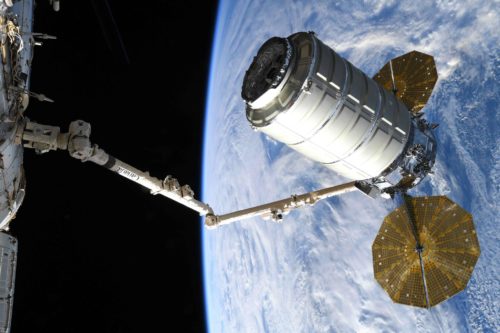
Assuming an on-time launch Wednesday, the NG-11 Space Ship Roger Chaffee will arrive at the International Space Station (ISS) early Friday morning. Photo Credit: NASA/Astronaut Ricky Arnold, via Twitter
Indeed, this extended-duration independent-flight capability will be trialed for the first time on NG-11, for Space Ship Roger Chaffee is scheduled to unberth from the station in July and conduct several months in free flight, before it is destructively deorbited in December. Although several previous Cygnuses have loitered in low-Earth orbit for up to a couple of weeks after departing the ISS—to conduct autonomous investigations, including the Spacecraft Fire Experiment, or Saffire—NG-11 will do so for much longer.
Assuming it berths at the station as scheduled on Friday, 19 April and unberths as scheduled on 23 July, the mechanized Roger Chaffee will log a record-setting 95 days attached to the ISS, eclipsing the previous record-holder, the NG-10 SS John Young, which ended its mission in February after 81 days’ berthed time. It remains to be seen exactly how long NG-11 will remain in autonomous free-flight, but it seems probable that it will eclipse the 100 days’ total time in space recorded by its immediate predecessor, NG-10.
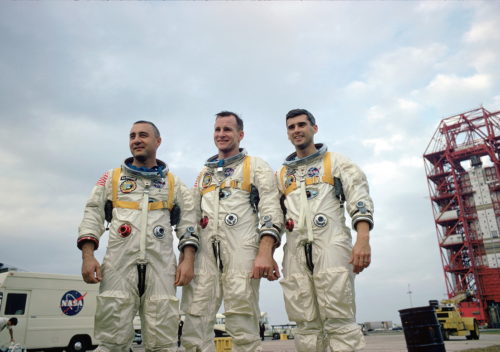
The Apollo 1 crew consisted of (from left) Command Pilot Virgil “Gus” Grissom, Senior Pilot Ed White and Pilot Roger Chaffee. Photo Credit: NASA
The NG-11 mission will close out the first phase of the Commercial Resupply Services (CRS1) contract, signed between NASA and Orbital Sciences Corp., way back in December 2008. This initially called for eight dedicated Cygnus missions, but with the increased uplift afforded by a pair of Atlas V launches and the larger payload envelope of the Enhanced Cygnus, this target was surpassed sooner than intended. Following the completion of an “extension” program, bridging the gap between the end of CRS1 and the beginning of the CRS2 phase—for which contracts were signed back in January 2016—it is expected that the NG-12 Cygnus mission, slated to launch late in 2019, will kick off the second phase of Commercial Resupply Services, lasting through 2024.
The choice of Roger Chaffee as this mission’s namesake is particularly timely. “In terms of the Chaffee choice, we tied it to the 50th anniversary of the Apollo 11 Moon landing this year,” Ms. Cox told AmericaSpace. “Chaffee had died just two years earlier in 1967—tragically—during that simulated launch of the Apollo 1 mission. Although his teammates had flown in space earlier, he never got the chance. We see Cygnus as a visible reminder of all that he did to pave the way for his fellow astronauts on that epic voyage to the Moon and all of the milestones that came after that. He made the ultimate sacrifice and we are proud to fly in his honor.”
For as Chaffee himself once remarked: “There’s a lot of unknowns and a lot of problems that could develop and have to be solved. And that’s what we’re there for. This is our business.”
The author would like to express sincere appreciation to Ms. Vicki Cox, Director of Communications for Northrop Grumman Innovation Systems, for her time in responding to questions for this preview feature.
.
.
FOLLOW AmericaSpace on Facebook and Twitter!
.
.
Missions » ISS » COTS » CYGNUS »



